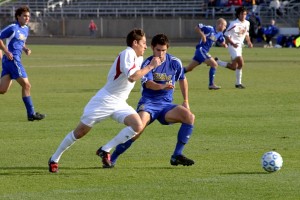How to play the 4-1-4-1 soccer formation

When it comes to deciding what formation you are going to use, there are many different factors that need to be taken into account. Most importantly, you need to have the players that are flexible enough to play in the defined positions, as well as having the depth of personnel to be able to maintain the formation even if there are injuries, suspensions etc.
The 4-1-4-1 formation is one of the more unconventional line-ups that are used, but it has become popular in recent years. Perhaps the main proponent of this formation is Pep Guardiola. Some people see it as being a hybrid version of the 4-3-3 or 4-2-3-1 formations. Other well-known teams that have lined up in this manner include the Spain team that captured to the Euro 2008 title and the German team that was managed by Joachim Löw at the World Cup in 2010.
In this article, you will learn about the basics of the formation, as well as the pros and cons of using it.
The Basics

The fulcrum of this formation is the lone defensive midfielder. This player has two very important parts to play in order to make this formation a viable and successful option. The first thing is that they have to help cover the defence and add an extra layer of protection by making hard tackles and putting attacking players under pressure. They also have to be a link between the defence and the attack. By playing in this sweeping role, they can really add value and support to both your defence and attack, depending on the situation at hand.
The central midfielders have differing roles in this formation. One of them has to play the traditional role of box to box, as well as helping out the defence when required. The other central midfielder is the main attacking threat in the partnership and has a license to get forward more often. These two players are vital throughout the game for dominating exchanges and ensuring that your team comes out with the right result.
The presence of the defensive midfielder allows the wingers to have a bit more freedom when getting up the pitch to attack and they don’t have to worry about defensive duties as much as they would have if you were using a more traditional formation. They can even float into the centre of the field and act as forwards when the situation seems fit. As the striker is on their own, they need to have a physical presence about them that allows them to hold onto the ball if support is needed, as well as a player who can link the play well.
Pros of the Formation
The main pro for this type of formation is that it allows for a very flexible approach. You can easily tweak and tailor it depending on how your opposition is lined out or how they are playing. If you want to go more defensive, you can drop the box to box midfielder alongside the defensive midfielder.
With the wingers being allowed the freedom to roam all around the pitch, it takes a lot of the opposition’s defence out of position and creates gaps and opportunities. If you are playing against a top quality side, this set up can frustrate them as you are keeping things a lot more compact.
Cons of the formation
If you are using this type of formation, the players on your team need to be specifically tailored for their given role. This requires a type of player that understands the system that you will be playing and how their role needs to be executed. You really do need the right personnel, especially when it comes to the midfield.
You can’t have two central midfielders who play the same way or the formation will not work. There also needs to be constant communication between the defensive midfielders and the two central midfielders. If you have an injury, you might not have a reserve of players that are able to easily step into a role that has been vacated. It is a very specialised formation.
Conclusion
When it comes to using the 4-1-4-1 formation, you need to have the right players for the job. Once you have the personnel who understand their role and they can execute it well, this is a very good formation for disrupting the opposition, especially if they are of a higher quality. It will take tweaking and practice to become comfortable with it, but once the team can run the formation smoothly, you can be very flexible in your approach to a match on a given day.
